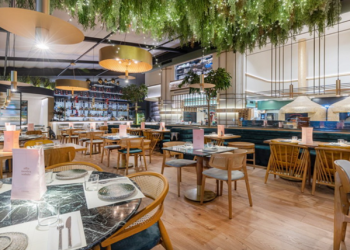In today’s cutthroat business world, a restaurant proprietor needs to be able to innovate and serve tasty food. Aside from the food, the restaurant’s ambiance is the primary way a customer interacts with it. When hundreds of eateries, cafes, and cafés are lined up on every street in the world, it might be challenging to stand out in terms of décor.
Although aesthetic factors like lighting, color, and music greatly influence buyers’ feelings, they are usually willing to pay less. On the other hand, furniture is a tangible asset that frequently generates profits.
According to a Rochester Institute of Technology study titled “Interior Design in Restaurants as a Factor Influencing Customer Satisfaction,” restaurant furniture has been identified as the most crucial element of interior design that influences overall customer satisfaction and willingness to pay more.
The fashion and comfort of your furnishings ultimately determine the final design of business spaces like restaurants. It might significantly enhance your turnover rates, reviews, and foot traffic if well received.
Use this quick primer to learn how vital the furnishings in your restaurant are to the customers, and you can start building the restaurant of your dreams right immediately.
LAYOUT
The design of your restaurant furniture should be well thought out before being assembled. This implies that your design approach for the space arrangement should be carefully considered to maximize customer satisfaction and profitability. A restaurant’s layout significantly impacts customers’ experiences, even if it’s rarely the first thing they mention in a favorable review. It is a well-acknowledged element of interior design.
Consumers often want spacious, airy settings. Your room should have a comfortable atmosphere without being unduly stuffy or crowded. A reasonable consumer experience depends on efficient traffic flow, claims an article. Both patrons and restaurant staff should go ahead in a stream. A lot less thrilling than entering the center atrium, for instance, is entering from the parking lot. Customers must experience the beginning, a taste of your ambiance, a staircase that can go to another story, the kitchen, and the facilities.
SEATING
The way a customer is situated affects how long they choose to remain. For instance, upscale restaurants commonly provide private dining rooms to increase sales and extend customer visits. Fast food establishments, like McDonald’s, employ metal or plastic seats in contrast.
It might be challenging to strike the right balance while choosing the right kind of seat. If the sitting was more comfortable, customers may stay too long and take up room. If it is uncomfortable, on the other hand, the consumer may opt not to revisit your restaurant.
To assist you in concentrating on the sorts of chairs you wish to utilize, the idea for your restaurant should be determined. Quick-serving restaurants commonly employ metal and plastic chairs because they are easy to clean. Wood is old and classic because it blends well with many different décor styles. It is used in midrange and family-friendly restaurants.
TABLEWARE
The restaurant motif impacts the tableware like it does the seating. Granite and wood tables are typical in fine dining venues due to their upscale and visually pleasant look. They, unfortunately, also demand more exceptional care.
Tables covered in laminate or made of melamine are less expensive options for quick-service and fast-food establishments. They are sturdy, easy to clean, and child-safe.
CONCLUSION
Furniture for restaurants is crucial to boosting sales and maximizing client satisfaction. With this clear manual for learning the fundamentals, it’s time to grow your business to new heights.














